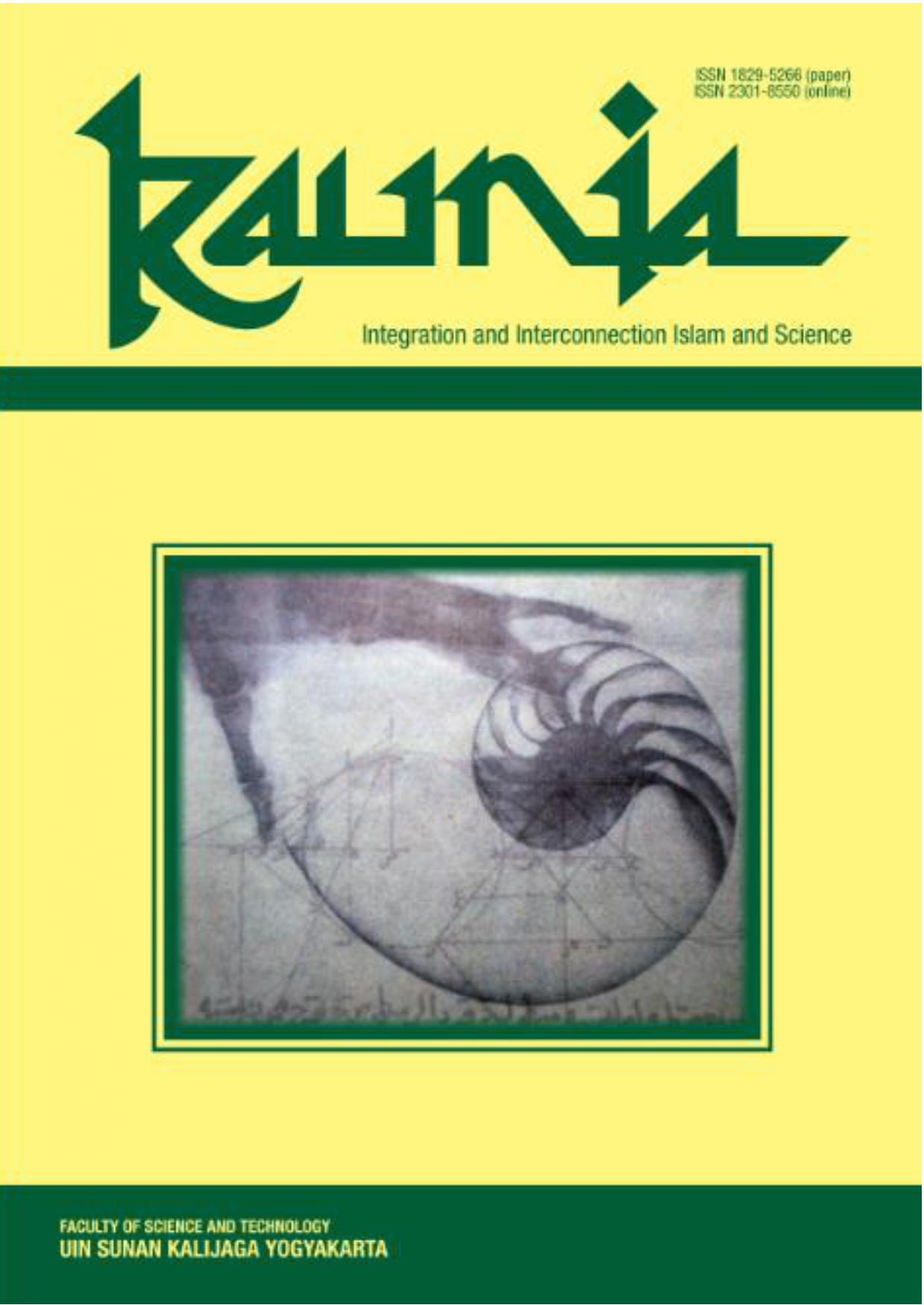Determination of Gibbs Free Energy in the Compound Formation of Li-P and Li-Fe-O by Pymatgen
DOI:
https://doi.org/10.14421/kaunia.3554Keywords:
API Key, Gibbs free energy, Li-Fe-O, Li-P, pymatgenAbstract
The Gibbs free energy of the compound formation from a phase diagram based on Python Materials Genomic (Pymatgen) and Application Programming Interface (API) Key had been determined. The compounds shown were stable synthesized from the combination of Li-P and Li-Fe-O atoms. This stability was indicated by the value of the Gibbs free energy of the compounds formation obtained from the phase diagram of each atomic combination. The diagram was created from the integration between Python and the database from the Materials Project via an API Key using Pymatgen. From the research conducted for the combination of Li-P atoms, compounds and the Gibbs free energy of formation shown were Li3 P (-0.697 eV/atom), LiP (-0.523 eV/atom), Li3 P7 (-0.36 eV/atom), and LiP7 (-0.159 eV/atom). For Li-Fe-O combination, the compound and the energy were Li5 FeO4 (-2.117 eV/atom), LiFeO2 (-2.072 eV/atom), LiO2 (-2.067 eV/atom), Li2 FeO2 (-1.979 eV/atom), Li2 FeO3 (-1.965 eV/atom), Fe2 O3 (-1.907 eV/atom), Fe3 O4 (-1.858 eV/atom), FeO (-1.728 eV/atom), Li2 O2 (-1.651 eV/atom), and LiO8 (-0.414 eV/atom). The most stable compound from each formation was the compound with the lowest Gibbs energy, i.e Li3 P and Li5 FeO4.
References
Engineering ToolBox (2017). Standard State and Enthalpy of Formation, Gibbs Free En- ergy of Formation, Entropy and Heat Capacity. https://www.engineeringtoolbox.com/ standard-state-enthalpy-formation- definition-value-Gibbs-free-energy- entropy-molar-heat-capacity-d_1978. html.
Jain, A., Ong, S. P., Hautier, G., Chen, W., Richards, W. D., Dacek, S., Cholia, S., Gunter, D., Skinner, D., Ceder, G., et al. (2013). Commentary: The materials project: A materials genome approach to accelerating materials innovation. APL materi- als, 1(1):011002, https://doi.org/10.1063/1.4812323.
Kinoshita, Y., Morishita, M., Nozaki, A., & Ya- mamoto, H. (2019). Thermodynamic Properties for Nd2 (MoO4 )3 Formed in the Nu- clear Fuel Waste Glasses. Materials Trans- actions, 60:111–120, https://doi.org/10.2320/matertrans.M2018305.
MacNeil, J. H., Massi, D. M., Zhang, J.-H., Ros- mus, K. A., Brunetta, C. D., Gentile, T. A., & Aitken, J. A. (2014). Synthesis, structure, physic- ochemical characterization and electronic struc- ture of thio-lithium super ionic conductors, li4ges4 and li4sns4. Journal of Alloys and Compounds, 586:736–744, https://doi.org/10.1016/j. jallcom.2013.10.011.
Mao, E., Wang, W., Wan, M., Wang, L., He, X., & Sun, Y. (2020). Confining ultrafine Li3 P nanoclusters in porous carbon for high-performance lithium-ion battery anode. Nano Research, 13(4):1122–1126, https://doi.org/10.1039/C0JM04225K.
Marom, R., Amalraj, S. F., Leifer, N., Jacob, D., & Aurbach, D. (2011). A review of advanced and practical lithium battery materials. Journal of Materials Chemistry, 21(27):9938–9954, https://doi.org/10.1039/C0JM04225K.
Morishita, M., Abe, T., Nozaki, A., Ohnuma, I., & Kamon, K. (2020). Calorimetric study of nd2 fe1 4b: heat capacity, standard gibbs energy of formation and magnetic entropy. Thermochim- ica Acta, 690:178672, https://doi.org/10.1016/j.tca.2020.178672.
Morishita, M., Ikeda, K., Nishimura, N., Miura, S., & Yamada, Y. (2012). Standard Gibbs energies of formation of the ferro-and paramagnetic phases of AlNd3 . The Journal of Physical Chemistry C, 116(38):20489–20495, https://doi.org/10.1021/jp301259n.
Nazri, G. (1989). Preparation, structure and ionic con- ductivity of lithium phosphide. Solid State Ionics, 34(1-2):97–102, https://doi.org/10.1016/0167-2738(89)90438-4.
Ong, S. P., Richards, W. D., Jain, A., Hautier, G., Kocher, M., Cholia, S., Gunter, D., Chevrier, V. L., Persson, K. A., & Ceder, G. (2012). Python materi- als genomics (pymatgen): A robust, open-source python library for materials analysis. Computational Materials Science, 68:314–319.
Photos, E. (1989). The question of meteoritic ver- sus smelted nickel-rich iron: Archaeological evi- dence and experimental results. World Archaeol- ogy, 20(3):403–421.
Popovich, A., Novikov, P., Wang, Q., Pushnitsa, K., & Aleksandrov, D. (2021). Synthesis method and thermodynamic characteristics of anode mate- rial Li3 FeN2 for application in lithium-ion batteries. Materials, 14(24):7562, https://doi.org/10. 3390/ma14247562.
S. Z. Wang, G. Z., Gao, J. L., Wang, J., Wang, Y. Y., Nan, C. J., Huang, D. Y., Chen, L. L., Song, J. F., & Luo, P. H. (2018). First-principles Study on LiFePO4 Materials for Lithium-Ion Bat- tery. In Proceedings of the International Work- shop on Materials, Chemistry and Engineering, vol- ume 1:IWMCE, page 6. https://doi.org/10.
/0007435601330138.
Stull, D. R (1971/03/01 1971). Identification of poten- tial chemical research hazards. Journal of Chem- ical Education, 48:p.A173, https://doi.org/10.1021/ed048pA173.
Taruminkeng, S., Mustopa, E. J., & Hendrajaya, L. (2016). Termodinamika dalam memahami proses pengolahan mineral. In Prosiding Semi- nar Nasional Fisika (E-Journal), volume 5, pages SNF2016–ERE. https://doi.org/10.21009/0305020607.
Yamasue, E., Shimizu, K., & Nagata, K. (2013). Direct Determination of Standard Gibbs En- ergies of the Formation of 4CaO.P2 O5 and 3CaO.P2 O5 by transpiration method. ISIJ international, 53(10):1828–1835, https://doi.org/10.2355/isijinternational.53.1828.
Downloads
Published
How to Cite
Issue
Section
License
Copyright (c) 2022 Kaunia: Integration and Interconnection Islam and Science Journal

This work is licensed under a Creative Commons Attribution-NonCommercial-ShareAlike 4.0 International License.
All articles published in Kaunia are licensed under a Creative Commons Attribution-NonCommercial-ShareAlike 4.0 International license, with the copyright to these articles held by the journal. Anyone is free to read, download, copy, distribute, print, search, link to full text articles, or transform an article, in any medium or format, provided they do so non-commercially, give appropriate credit to Kaunia, and distribute any derivative work under the same (or equivalent) terms.
By submitting to Kaunia, authors agree to both the terms of the CC BY-NC-SA license and the automatic transfer of the copyright to their article if it is accepted.









